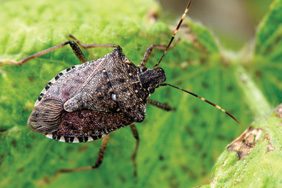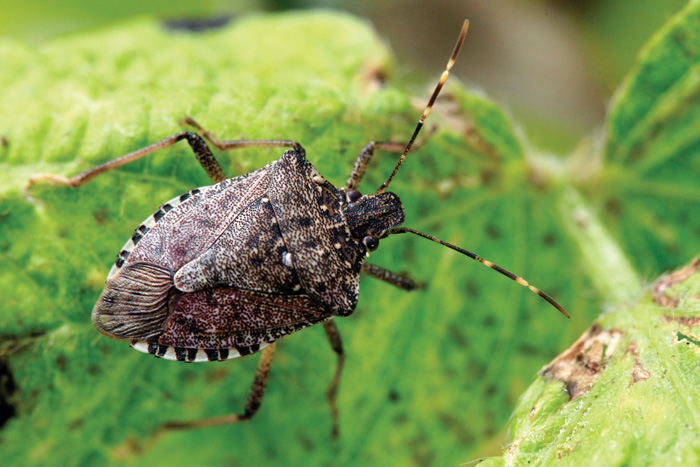Stink bugs can damage trees, shrubs and much more


A brown marmorated stink bug at a Penn State research station in Biglerville, Pa. The pest, originally from Asia is threatening to wreak havoc on mid-Atlantic orchards.
By Linda C. DOLAK
OSU Extension Volunteer
11Stink bugs are true bugs (order: Hemiptera), meaning they go through incomplete metamorphosis. When the eggs hatch, they are nymphs, resembling the adult bug, unlike bugs that go through complete metamorphosis such as beetles, moths and butterflies. The word “marmorated” means having marbled, veined, or streaked appearance.
The adult stink bugs are shield-shaped with needle-like sucking mouths. They are mottled white and brown, dark brown, and have creamy bands on the antennae, legs and outside edge of the abdomen (back end). They are about 1/2- to 2/3-inch long, and have the ability to release a chemical with a foul odor when they feel they’re in danger.
Its eggs and nymphs are found on the undersides of leaves, usually from June through August. A single female can lay up to 400 eggs outdoors during its lifetime, which is one summer. The nymphs have a more striking color than the adults: a yellowish background with mottled red and black. As the nymphs go through five molting periods, they gradually increase in size and color before becoming adults.
The BMSB will begin to look for shelter from late August through the end of October, usually in protected structures such as leaf litter and dead vegetation. They usually leave the structure from April through the middle of May. There are increasing numbers of these bugs through the autumn.
The stink bug is a strong flier, so it is able to feed on a large variety of host plants.
They have the ability to cause significant damage to fruit trees, citrus, persimmon, raspberries, grapes, sweet corn and more. They will also feed on various perennials, trees and shrubs, such as honeysuckle, lilac, linden, maple, oak, rose and sycamore, to name a few. They will not cause structural damage or reproduce in homes.
The BMSB is not known to transmit disease or cause harm to humans or animals, as they do not feed on their blood. Few people may be sensitive or allergic to the BMR chemical, and should consult with a physician if there is an abnormal reaction.
It is advisable to seal, fill or repair all entry points, such as cracks around doors, windows, joints, siding and shingles. Few chemicals have been developed to be used on it. Some are labeled for it, but most have little effectiveness, as they tend to break down when exposed to sunlight. There are currently no biological controls in the United States. The bugs can be hand-picked from the surface they have landed on, or if there are many, a vacuum cleaner can be used gently. However, the odor from the bugs may remain in the vacuum over a short period of time.
For more information: http://go.osu.edu/stink.
 43
43
